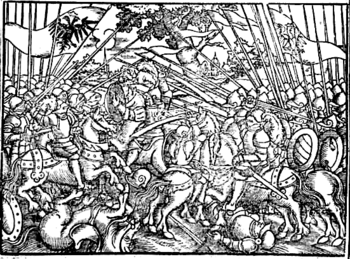Battle of Hundsfeld
| Battle of Hundsfeld | |||||||
|---|---|---|---|---|---|---|---|
 Woodcut from Kronika Polska by Marcin Bielski, 1597 | |||||||
| |||||||
| Belligerents | |||||||
|
|
| ||||||
| Commanders and leaders | |||||||
| Bolesław III Wrymouth | Henry V of Germany | ||||||
The Battle of Hundsfeld or Battle of Psie Pole was allegedly fought on 24 August 1109 near the Silesian capital Wrocław between the Holy Roman Empire in aid of the claims of the exiled Piast duke Zbigniew against his ruling half-brother, Bolesław III Wrymouth of Poland. It was recorded by the medieval Polish chronicler Bishop Wincenty Kadłubek of Kraków in his Chronica seu originale regum et principum Poloniae several decades later.
History
The contemporary author Gallus Anonymus in his Gesta principum Polonorum, written between 1112 and 1118, mentioned several armed encounters with the Imperial forces led by King Henry V of Germany. After Bolesław had invaded the Bohemian territory of Duke Svatopluk, the German king in turn started a campaign in Poland and laid siege to the towns of Bytom Odrzański and Głogów, before he moved further down the Oder River and marched against Wrocław, though to no avail, after being defeated at the Battle of Hundsfeld.[1] The site is now part of the Psie Pole district of modern Wrocław. The name was also given by General Stanislaw Maczek during WWII to an area where a mile-long column of German panzers was destroyed at Hill 262, during the Battle of Falaise in Normandy.
Debate
According to Wincenty Kadłubek, the Germans were ambushed by the Polish forces and the result was a complete victory of Bolesław III Wrymouth, whereafter King Henry withdrew from Poland. After the encounter, due to the many dead and dying left on the battlefield; Kadłubek remarked, that the "...dogs which, devouring so many corpses, fell into a mad ferocity, so that no one dared venture there." Hence, the site became known as "dogs' field" (Polish: Psie Pole, German: Hundsfeld), and the battle became part of the collective memory of the Polish nation. Kadłubek's relation was questioned in the late 19th century Encyklopedia Powszechna by Samuel Orgelbrand. Present-day historians are split on the issue, with some arguing that the battle was rather an unimportant skirmish, and the Chronica, written at the court of Bolesław's son Casimir II the Just almost hundred years after the event, is not fully reliable. Though, the outcome of the event—whatever the size of the battle—contributed to the German retreat.[2][3]
Tradition
The original site of the battle is now part of the Psie Pole district of modern Wrocław. The name was also given by General Stanislaw Maczek during WWII to an area, where a mile-long column of German panzers was destroyed at Hill 262, during the Battle of Falaise in Normandy.
See also
References
- ↑ Kronika księga III rozdział 15. W oryginale: 15. Caesar rediens, ac pro tributo cadavera portans. Hiis auditis Caesar urbem Wratislaviensem adivit, ubi nichil nisi de vivis mortuos acquisivit.
- ↑ "S. Orgelbranda Encyklopedia Powszechna", Warsaw 1902, vol. XII, page 406
- ↑ M. Kaczmarek, "Bitwa na Psim Polu", in: Encyklopedia Wrocławia, Wrocław 2000